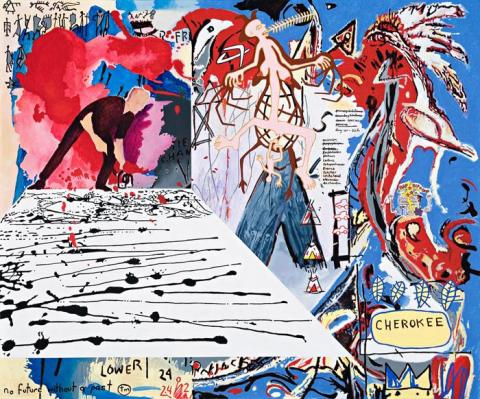NOTES TO BASQUIAT: CUT THE CIRCLE II, 2001
Gordon Bennett
synthetic polymer paint on linen
152.0 x 182.5 cm
signed and dated verso: G. Bennett 8 -03-2001
title, medium and dimensions inscribed verso: NOTES TO BASQUIAT: CUT THE CIRCLE II / Acrylic on linen / 5 x 6, 152 x 182.5 cm
Sherman Galleries, Sydney, 2001
Acquired from the above
Private collection, Melbourne
Notes to Basquiat: Modern Art, Sherman Galleries, Sydney, 17 May – 9 June 2001
Since his first major solo exhibition in 1989, Gordon Bennett has achieved international acclaim for his compelling, highly idiosyncratic vision which, drawing inspiration from Australia's colonial past and postcolonial present, interrogates the power of language to structure the ideologies that so determine our cultural and personal identities. Indeed, perhaps more directly and explicitly than any other Australian artist, he has engaged in the debate on republicanism, sovereignty (land rights) and citizenship in an effort to highlight the plight of indigenous people - not just locally, but internationally - who have become estranged as a result of colonialism. Arguing that the codes of Western art, literature, law and science introduced with European settlement have become a prison from which indigenous people cannot escape - but rather, only appropriate - thus Bennett employs the deconstructivist aesthetic of postmodernism to re-present the histories and politics underlying the Australian social landscape.
In 1998, seeking to communicate his concerns to an American audience, Bennett embarked upon his celebrated 'Notes to Basquiat' series inspired by the work of Jean-Michel Basquiat, the African-American artist based in New York who shared a similar preoccupation with semiotics and visual language as instruments of marginalisation. Conceived as an 'open letter' to Basquiat who died in 1988, the series appropriates the raw street style for which the African-American artist became renowned, thus emphasising 'our shared experience as human beings in separate worlds that each seek[s] to exclude, objectify and dehumanise the black body and person.'1 Yet if Bennett borrows 'signature' motifs from Basquiat's oeuvre such as his use of lists and rap-like banter, he nevertheless imbues them with his own uniquely Australian symbolism. As Jill Bennett elucidates, Bennett '...does not simply imitate or act as Basquiat... [Rather] he is interested in how Basquiat's work might be encountered from a different place, and what happens when different accounts of history and experience are registered simultaneously within a given frame...'2
Notes to Basquiat: Cut the Circle II 2001 belongs to the group of paintings within this series which juxtapose Basquiat's rap style with the characteristic interlaced lines of Jackson Pollock, a mythic figure in modernism and thus, according to Bennett, an important player in the conspiracies of colonial cultures. Depicted in every composition as the black and pink iconic dancing figure, Pollock, however, is not simply a convenient image-maker that suits Bennett's argument. More significantly, Pollock is a way of bringing Basquiat home to Australia '...for Pollock has a place within Australia's psyche because of the Blue Poles fiasco. Prime Minister Whitlam's purchase of the painting made it emblematic of his Government's radicalism and determination to move on rather than remain in the past... Bennett's return to Pollock is like a calling card reminding the Howard government that the ghost is still out there.'3
1. Bennett quoted in Gordon Bennett, National Gallery of Victoria, Melbourne, 2007, p. 21
2. ibid.
3. McLean, I., 'Conspiracy Theory: Pollock, Basquiat, Bennett' in Gordon Bennett, Notes to Basquiat: Modern Art, Sherman Galleries, Melbourne, n.p.
VERONICA ANGELATOS
